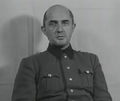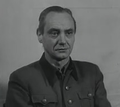Top Qs
Timeline
Chat
Perspective
Pohl trial
From Wikipedia, the free encyclopedia
Remove ads
The United States of America vs. Oswald Pohl, et al., commonly known as the Pohl trial, was the fourth of the twelve "subsequent Nuremberg trials" for war crimes and crimes against humanity after the end of World War II between 1947 and 1948. The accused were SS-Obergruppenführer Oswald Pohl and 17 other SS officers employed by the SS Main Economic and Administrative Office charged for their administration of, and active involvement in, the Nazi concentration camp system.
The Pohl trial was held by United States authorities at the Palace of Justice in Nuremberg in the American occupation zone before US military courts, not before the International Military Tribunal.[1] Four of the accused, including Pohl, were sentenced to death by hanging, three to life imprisonment, eight to prison sentences from 10 to 25 years, and three were acquitted.[2]
The judges in this case, heard before Military Tribunal II, were Robert M. Toms (presiding judge), Fitzroy Donald Phillips, Michael A. Musmanno, and John J. Speight as an alternate judge. The chief of counsel for the prosecution was Telford Taylor; James M. McHaney and Jack W. Robbins were the principal prosecutors. The indictment was presented on January 13, 1947; the trial began on April 8, and sentences were handed down on November 3, 1947. At the request of the judges, the court reconvened on July 14, 1948, to consider additional material presented by the defense. On August 11, 1948, the tribunal issued its final sentences, confirming most of its earlier sentences, but slightly reducing some of the prison sentences and changing the death sentence of Georg Lörner into a sentence of life imprisonment.[2]
Remove ads
Case
SS-Obergruppenführer Oswald Pohl was chief of the SS Main Economic and Administrative Office (WVHA), the organization responsible for managing the finances, supply systems and business projects of the Allgemeine-SS, and procurement for the Waffen-SS. The WHVA was responsible for administration of the Nazi concentration camps, the Concentration Camps Inspectorate, and the SS-Totenkopfverbände in the implementation of the Final Solution.[1] Pohl, as chief of the WHVA, was technically the top administrator of the Nazi system of concentration camps and extermination camps. Seventeen WHVA officials were also charged for their involvement in the concentration camp system, including three of Pohl's deputy chiefs.
Remove ads
Indictment
The indictment presented by a grand jury charged the defendants with the following.
- Participating in a common plan or conspiracy to commit war crimes and crimes against humanity.
- War crimes through the administration of concentration camps and extermination camps, and the mass murders and atrocities committed there.
- Crimes against humanity on the same grounds, including slave labor charges.
- Membership in a criminal organization, the SS. Note: The SS had been found a criminal organization previously by the IMT.
All defendants were charged on all counts of the indictment, except Hohberg, who was not charged on count 4. Charge 1 (conspiracy) was largely disregarded by the tribunal and no judgments on this count were passed.
Remove ads
Defendants
Summarize
Perspective
All convicts were found guilty on charges 2, 3, and 4, except Hohberg (who was not charged on count 4, but found guilty on counts 2 and 3). Three defendants were acquitted on all charges: Vogt, Scheide, and Klein.
Hohberg's sentence of 10 years included time already served—he was imprisoned on October 22, 1945—because he was not a member of the SS. The defense counsel for Karl Sommer filed a petition to modify the sentence to General Lucius D. Clay, the Commander-in-Chief for the American occupation zone in Germany. In response to this appeal, Clay ordered Sommer's death sentence to be commuted into a lifetime imprisonment on May 11, 1949.[3] Pohl kept proclaiming his innocence, saying he had been only a lower functionary. He was hanged on June 7, 1951, at Landsberg Prison.
Richard Glücks, the head of Amt D: Konzentrationslagerwesen (the WVHA department for concentration camps), had been the direct superior of all commanding officers at concentration camps and, as such directly responsible for all the atrocities committed there, was not tried. On May 10, 1945, two days after the unconditional surrender of Germany, Glücks had committed suicide in the navy hospital of Flensburg.[4]
Remove ads
See also
References
External links
Wikiwand - on
Seamless Wikipedia browsing. On steroids.
Remove ads



















